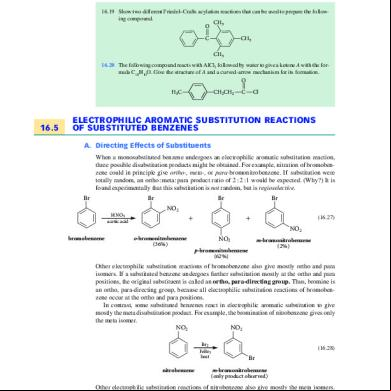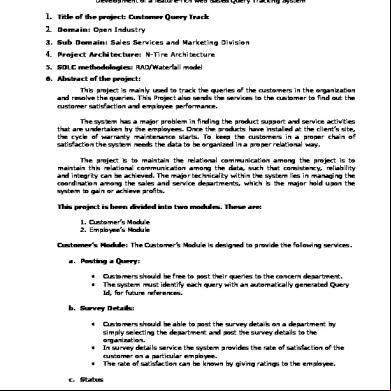Determination Of Reaction Mechanism 1b633o
This document was ed by and they confirmed that they have the permission to share it. If you are author or own the copyright of this book, please report to us by using this report form. Report 3b7i
Overview 3e4r5l
& View Determination Of Reaction Mechanism as PDF for free.
More details w3441
- Words: 1,191
- Pages: 57
KINETIC AND NON-KINETIC METHODS OF STUDY OF REACTION MECHANISMS.
Dr.K.RAJARAJAN.M.Sc;M.Phil;Ph.D. Assistant prof. of chemistry, Rajah Serfoji Govt. College, Thanjavur-613 005. 1
1. AIMS
AND OBJECTIVES 2. INTRODUCTION 3. KINETIC AND THERMODYNAMICS CONTROL OF A REACTION 4. MICROSCOPIC REVERSIBILITY 5 HAMMOND’S POSTULATE 6.KINETIC AND NON-KINETIC METHODS OF STUDY OF REACTION MECHANISMS
2
KINETIC METHODS - PRIMARY AND SECONDARY KINETIC ISOTOPIC EFFECT NON-KINETIC METHODS OF STUDY OF REACTIONMECHANISM
3
Identification of products: Identification of the intermediate: Isotopic labeling Stereo Chemistry evidences Stereo Chemical Method
4
AIMS AND OBJECTIVES The aim is to motivate and enable a comprehensive knowledge on kinetic and nonkinetic methods of study of reaction mechanisms to the students. On successful completion of this lesson the student should have: Understood the kinetic and non-kinetic methods of study of reaction mechanisms
5
INTRODUCTION Under reversible reaction conditions the ratio of possible products is determined by the relative stability of each product, measured by its standard free energy (DG0). The composition of the equilibrium mixture does not depend on how fast (DG‡) each product is formed in the reaction. This is termed thermodynamic (or equilibrium) control. On the other hand when the quantity of each product is formed and is not a function of the relative stability (DG0) of each product, one calls it kinetic control reaction. 6
KINETIC AND THERMODYNAMICS CONTROL OF A REACTION A given set of the reaction at the given condition, some times two products may formed i.e., two isomeric products. As a mixture in such a reaction one product is called kinetically controlled and the other one is called thermodynamically controlled product.
7
8
9
The one which has high activation energy is more stable product and this product is thermodynamically controlled product. The one has low activation energy is less stable product this product is kinetically controlled products. (i). Both the steps are irreversible then the product will contain more C. (ii). If both the steps are reversible and if the reaction is stopped before the equilibrium attain then also we get more kinetic controlled product C. (iii). If both the steps are reversible and the equilibrium is reached, then we get the B which is thermodynamic controlled product is formed. 10
11
MICROSCOPIC REVERSIBILITY In a reversible reaction the forward and reverse reactions must follow the same mechanism. This phenomenon is called the principle of microscopic reversibility. Example: In the dehydration of an alcohol, an olefin is format via. a carbonium ion intermediate, as a consequence of the principle of the microscopic reversibility, the reverse reaction i.e., the acid catalyzed hydration of olefin to alcohol, must involve the same carbonium ion. 12
13
HAMMOND’S POSTULATE For any single reaction step, the geometry of the transition state resembles to the side to which it is closer in energy. Example (i): In the exothermic reaction the energy of transition state is closer to reactant. So the geometry of transition state resembles as reactant.
14
15
Example (ii): In SN1 reaction, there will be two transition state, energy of these transition state are closer to intermediate so the geometry of transition state resembles as intermediate.
16
17
Methods that are used to determine to Reaction Mechanism: (i) Kinetic Methods (ii) Non-Kinetic Methods
18
KINETIC METHODS PRIMARY AND SECONDARY KINETIC ISOTOPIC EFFECT This will observed if the C-H bond cleavage takes place in a slow step mechanism. Isotopic substitution will give acceptable charges, i.e., the rate of the reaction
19
20
This reaction can be catalyzed by both an acid and a base. The rate of the reaction depend on, (i) Catalyst (ii) Reactant (iii) Independent of Br2
21
22
23
24
25
First let us assume step (i) is slow and step (ii) is fast. The rate constant for the nitration of benzene is KH. The rate constant for the nitration of benzene is KH. The rate constant for the nitration of deuterated benzene is KD. The step (ii) alone involves the C-H bond breaking. Here in this case KH=KD there is kinetic isotopic effect. If we consider the (ii), i.e., step (ii) as fast and (ii) as rate determining then KH is not equal to KD. But the experimental result shows that KH/KD = 1. There is no isotopic effect. 26
The kinetic isotopic effect shows that the first step is the rate determining step and it does not involve the C-H bond breaking. In some of the reaction the C-H bond breaking is not the rate determining step. But there will be isotopic effect, even though the C-H bond breaking is not involved in the determining step. This effect is called the secondary kinetic isotopic effect.
27
NON-KINETIC METHODS OF STUDY OF REACTIONMECHANISM Non-Kinetic method involves the following steps. a) Identification of product b) Identification of intermediate c) Isotopic labeling d) Stereo chemical evidences:
28
Identification of products The most fundamental basis for mechanistic speculation i.e., the identification of the products, without such intermediate we can’t be sure which reaction actually occurs under the given conditions. This should for all the products, relative proportion of the product and also the product formed by the side reaction
29
30
31
Identification of the intermediate Among the most concrete evidence obtained about the mechanism of the reaction is that provided by the actual isolation and identification of one or more intermediates from the reactions mixtures. (i) Isolation of an intermediate It is sometimes possible to isolate an intermediate from a reaction mixture by stopping the reaction after a short time or by use of very mild conditions 32
33
34
35
36
37
38
Carbon has two isotopes C14 is the radio active so we label the C in RCOO- is RC14OO but in the product C14 is present in alkylcyanide. Eg: Ester hydrolysis whether it is acid catalysis and basic catalysis in involves two types cleavage.
39
O18 in the products is found out by the help of mass spectrum i.e., the acid and the alcohol are analysed and the heavy isotope O18 is present in the acid i.e., confirms the acyloxygen cleavage present.
Stereo Chemical evidences Olefins undergo addition because the double bond is rich in electron. It is a univalence atom so we add 2 atoms. (i) Two atoms are added simultaneously this is called constructed mechanism.
Whether cis or trans isomer, carbonium ion intermediate is formed means because of single bond is capable of free rotation and the two acids i.e., maleic and fumaric acid leads to the same product because the bulky –COOH groups in the maleic acid intermediate and hindrance and it forms the intermediate of trans isomer.
If it is bromium ion intermediate means the rotation is not possible. If it is cyclic bromonium ion intermediate means the intermediate obtained by cis and trans isomers are not identical. So the products are different i.e., it retained the stereo chemistry of the reactant.
Stereo Chemical Method Organic substance exhibits in stereo isomerism i.e., geometrical isomerism and optical isomerism in the case of optical isomerism the starting material is in meso active or racemic form, after the reaction is completed then also we have to see the nature or seterochemistry of the product.
Dr.K.RAJARAJAN.M.Sc;M.Phil;Ph.D. Assistant prof. of chemistry, Rajah Serfoji Govt. College, Thanjavur-613 005. 1
1. AIMS
AND OBJECTIVES 2. INTRODUCTION 3. KINETIC AND THERMODYNAMICS CONTROL OF A REACTION 4. MICROSCOPIC REVERSIBILITY 5 HAMMOND’S POSTULATE 6.KINETIC AND NON-KINETIC METHODS OF STUDY OF REACTION MECHANISMS
2
KINETIC METHODS - PRIMARY AND SECONDARY KINETIC ISOTOPIC EFFECT NON-KINETIC METHODS OF STUDY OF REACTIONMECHANISM
3
Identification of products: Identification of the intermediate: Isotopic labeling Stereo Chemistry evidences Stereo Chemical Method
4
AIMS AND OBJECTIVES The aim is to motivate and enable a comprehensive knowledge on kinetic and nonkinetic methods of study of reaction mechanisms to the students. On successful completion of this lesson the student should have: Understood the kinetic and non-kinetic methods of study of reaction mechanisms
5
INTRODUCTION Under reversible reaction conditions the ratio of possible products is determined by the relative stability of each product, measured by its standard free energy (DG0). The composition of the equilibrium mixture does not depend on how fast (DG‡) each product is formed in the reaction. This is termed thermodynamic (or equilibrium) control. On the other hand when the quantity of each product is formed and is not a function of the relative stability (DG0) of each product, one calls it kinetic control reaction. 6
KINETIC AND THERMODYNAMICS CONTROL OF A REACTION A given set of the reaction at the given condition, some times two products may formed i.e., two isomeric products. As a mixture in such a reaction one product is called kinetically controlled and the other one is called thermodynamically controlled product.
7
8
9
The one which has high activation energy is more stable product and this product is thermodynamically controlled product. The one has low activation energy is less stable product this product is kinetically controlled products. (i). Both the steps are irreversible then the product will contain more C. (ii). If both the steps are reversible and if the reaction is stopped before the equilibrium attain then also we get more kinetic controlled product C. (iii). If both the steps are reversible and the equilibrium is reached, then we get the B which is thermodynamic controlled product is formed. 10
11
MICROSCOPIC REVERSIBILITY In a reversible reaction the forward and reverse reactions must follow the same mechanism. This phenomenon is called the principle of microscopic reversibility. Example: In the dehydration of an alcohol, an olefin is format via. a carbonium ion intermediate, as a consequence of the principle of the microscopic reversibility, the reverse reaction i.e., the acid catalyzed hydration of olefin to alcohol, must involve the same carbonium ion. 12
13
HAMMOND’S POSTULATE For any single reaction step, the geometry of the transition state resembles to the side to which it is closer in energy. Example (i): In the exothermic reaction the energy of transition state is closer to reactant. So the geometry of transition state resembles as reactant.
14
15
Example (ii): In SN1 reaction, there will be two transition state, energy of these transition state are closer to intermediate so the geometry of transition state resembles as intermediate.
16
17
Methods that are used to determine to Reaction Mechanism: (i) Kinetic Methods (ii) Non-Kinetic Methods
18
KINETIC METHODS PRIMARY AND SECONDARY KINETIC ISOTOPIC EFFECT This will observed if the C-H bond cleavage takes place in a slow step mechanism. Isotopic substitution will give acceptable charges, i.e., the rate of the reaction
19
20
This reaction can be catalyzed by both an acid and a base. The rate of the reaction depend on, (i) Catalyst (ii) Reactant (iii) Independent of Br2
21
22
23
24
25
First let us assume step (i) is slow and step (ii) is fast. The rate constant for the nitration of benzene is KH. The rate constant for the nitration of benzene is KH. The rate constant for the nitration of deuterated benzene is KD. The step (ii) alone involves the C-H bond breaking. Here in this case KH=KD there is kinetic isotopic effect. If we consider the (ii), i.e., step (ii) as fast and (ii) as rate determining then KH is not equal to KD. But the experimental result shows that KH/KD = 1. There is no isotopic effect. 26
The kinetic isotopic effect shows that the first step is the rate determining step and it does not involve the C-H bond breaking. In some of the reaction the C-H bond breaking is not the rate determining step. But there will be isotopic effect, even though the C-H bond breaking is not involved in the determining step. This effect is called the secondary kinetic isotopic effect.
27
NON-KINETIC METHODS OF STUDY OF REACTIONMECHANISM Non-Kinetic method involves the following steps. a) Identification of product b) Identification of intermediate c) Isotopic labeling d) Stereo chemical evidences:
28
Identification of products The most fundamental basis for mechanistic speculation i.e., the identification of the products, without such intermediate we can’t be sure which reaction actually occurs under the given conditions. This should for all the products, relative proportion of the product and also the product formed by the side reaction
29
30
31
Identification of the intermediate Among the most concrete evidence obtained about the mechanism of the reaction is that provided by the actual isolation and identification of one or more intermediates from the reactions mixtures. (i) Isolation of an intermediate It is sometimes possible to isolate an intermediate from a reaction mixture by stopping the reaction after a short time or by use of very mild conditions 32
33
34
35
36
37
38
Carbon has two isotopes C14 is the radio active so we label the C in RCOO- is RC14OO but in the product C14 is present in alkylcyanide. Eg: Ester hydrolysis whether it is acid catalysis and basic catalysis in involves two types cleavage.
39
O18 in the products is found out by the help of mass spectrum i.e., the acid and the alcohol are analysed and the heavy isotope O18 is present in the acid i.e., confirms the acyloxygen cleavage present.
Stereo Chemical evidences Olefins undergo addition because the double bond is rich in electron. It is a univalence atom so we add 2 atoms. (i) Two atoms are added simultaneously this is called constructed mechanism.
Whether cis or trans isomer, carbonium ion intermediate is formed means because of single bond is capable of free rotation and the two acids i.e., maleic and fumaric acid leads to the same product because the bulky –COOH groups in the maleic acid intermediate and hindrance and it forms the intermediate of trans isomer.
If it is bromium ion intermediate means the rotation is not possible. If it is cyclic bromonium ion intermediate means the intermediate obtained by cis and trans isomers are not identical. So the products are different i.e., it retained the stereo chemistry of the reactant.
Stereo Chemical Method Organic substance exhibits in stereo isomerism i.e., geometrical isomerism and optical isomerism in the case of optical isomerism the starting material is in meso active or racemic form, after the reaction is completed then also we have to see the nature or seterochemistry of the product.










